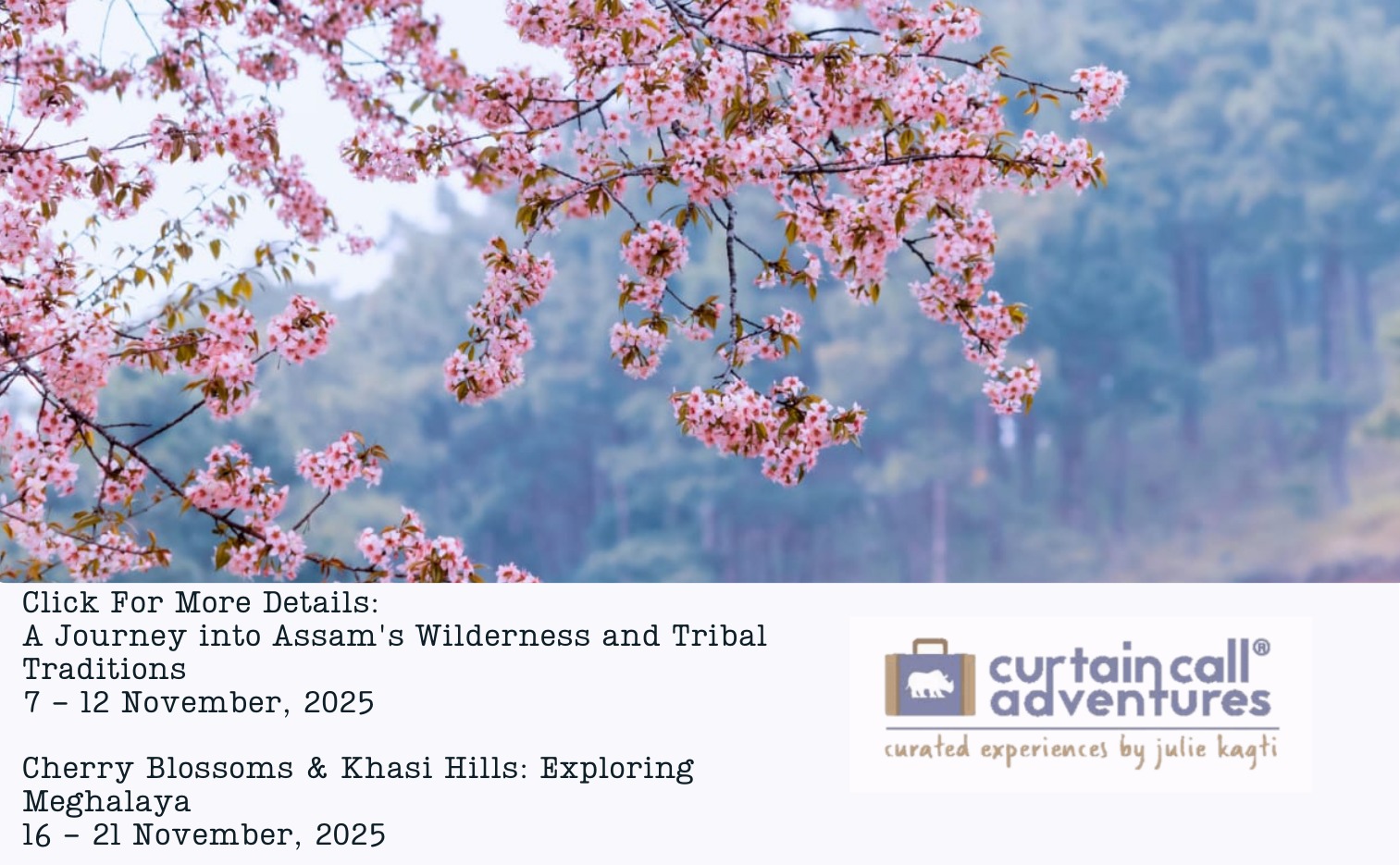One of the things on my bucket list has been to do a solo trip into the eastern Himalayas, to see how the indigenous tribes that inhabit these mountains, live. I first heard of Ziro from my parents, who had visited in the mid 1980’s and later through friends and social media about the Apatani tribe that live there permanently in 6 villages. I was told that a large part of the population still follow the customs and faithfully practice the rituals of a very old religion called, Donyi-Polo, the praise of the Sun (Ayo Donyi) and the Moon (Atoh Polo) . So a week ago I left my children with my aunt in Guwahati and set off with a driver and a four-wheel drive vehicle for Arunachal Pradesh .


The drive from Nameri to Ziro is 8 hours and in the rainy season not for the fainthearted . I was warned by my cousin about landslides and had stocked up on stuff like instant noodles, biscuits, juices, mosquito repellent etc . The scenery makes up for the road quality and driving through the mountains filled with exotic vegetation and waterfalls half covered in misty clouds is quite heady. I had my first glimpse of a huge mithu, a feral oxen that lives in the hill forests of the eastern Himalayas. It is considered a sacred animal by the ethic tribes that occupy these hills. These animals are sacrificed during religious rituals and are given to the bride’s family, before a wedding, as a bride price by the groom.


We reached the hotel around three in the afternoon after stopping for lunch at Ziro town. I decided to go for a small walk nearby to stretch my legs and get a feel for the place. I had seen a small pine groove from my room and thought it might be a nice spot to walk to. As I came out of the hotel gates and started wandering down the road, I saw some women busy planting paddy in a nearby field. I took out my camera and clicked a few pictures and noticed that the women had stood up and were waving in my directions, all smiles. I too waved back and continued towards the pine groove.

After my little walk, I was heading back to the hotel and looked to see how the women were doing with their planting. They again looked up and started gesturing for me to come down and meet them. I looked around and spotted a small make shift ladder propped up connecting the road to the fields below . I climbed down and meandered over to them. They were very excited to know I was Indian and could speak Hindi. When I mentioned that I now live in Mumbai, one of them burst into the popular Hindi cinema song – “Bombay se aaya mere dost…” which translate as – my friend has come from Bombay. It was a icebreaker and got all of us smiling and joining along.

They were a group of eleven, the youngest must have been 11 and I judge that the eldest would be in her early 60’s but I could be way off the mark as hill people have such timeless faces. Most of them had government jobs, varying from a peon/sweeper ( my Bombay se aaya friend) to an officer in the Agricultural department, in whose field they were planting. The children were studying in private schools in town. Every year during planting time which is in May they all take a month off work and help each other plant paddy in their fields. Even during the harvest season which is at the end of October. They weren’t related, just neighbours and friends. Paddy, they said, was a very important crop for them and was cultivated only once a year as in the winter months it’s too cold and the fields are full of frost.

Rice is a staple part of their diet, along with boiled meat and vegetables. Meat is mainly beef, chicken, pork, rats, caterpillars and small bugs. In the paddy fields, filled with water, most farm carp fish too. Wild ferns, bamboo shoot, a range of mushrooms, millet are part of their vegetable range.They offered me tea and were curious about the food served in the hotel. So I asked the hotel to make pakoras ( a savoury tea time snack) for 5.30pm , when they would wrap up for the day. While they worked in the fields, I took out my sketchbook and started sketching them and the landscape around us. I declined offers to help them with the planting though they had an extra pair of rubber boots . I think the early morning start of 5am was beginning to kick in. All of them were dressed in full sleeve t-shirts with shirts on top , long pants , knee-length galoshes, scarves or hats covered their heads and offered some protection from the sun and drizzle that took turns that day. The older women even had a half sarong tied around their waist.

The women told me over tea and snack, that they had moved out of their villages and into town as it was more convenient to get jobs and send kids to school. They went back to the village sometimes during festival time to practise the rituals but a few of them had converted to Christianity. When asked why , they said they believed in the Donyi-Polo rituals and sacrifices. But once one started the sacrifices, it had to be offered every year as per the custom. So opting for Christianity was more convenient. A lot of people were leaving the villages to find work in Itanagar too ( that’s the state capital) The government was the main employer here. Slowly a few people were beginning to abandon their fields.

One of the girls, studies at a college in Shillong, the state capital of Meghalaya and had come home for holidays to help her mother. We exchanged our Facebook details and I promised to send all the photographs I had taken of them. Photos of my husband and children were passed around , admired along with comments of how I only have two kids while each of them had a minimum of 6 each. After we all exchanged hugs and a promise to visit during the Myoko festival in March, they changed their outfits for cleaner drier ones, packed up their huge lunch boxes and flasks into the back of two Maruti Suzuki cars , got in and drove off.

Next day I went with my guide for a walk through two of the larger villages, Hong and Hari . I noticed that a few concrete houses had come up along side the traditional wood and bamboo houses on stilts, the younger women didn’t have the tattoo marking on their faces . Nor did they wear the large wooden nose plugs, called as yaping hurlo. The young generations were very fashion forward in contemporary clothing and stylish hair do’s. I am still in awe of a group of girls who passed me by , on the way down a muddy mountainside in 6″ stilettos while I barely managed to trudge along in my walking shoes. Tattooing the faces of young women has stopped being practised since the 1980’s. In olden days when the tribes hunted and fought other tribes, the women of the Apatani tribe were considered to be the most beautiful in the eastern Himalayas and were often kidnapped by invaders. This led to a unique tradition where the Apatani men started to tattoo their women and made them wear large nose plugs. I saw a lot of old women walking around who had tattooed faces.

Observing the traditional houses and village life with the symbols of the rituals and everyday customs that are still practised in the same way many generations have done over centuries is a thrill I can only describe as finding a treasure. A visit to the market at Ziro, clearly indicates the transition that has started , old women in traditional outfits with tattooed faces sell fat yellow caterpillars, baskets, knives along side small shops filled with cheap China made fashionable clothing and vendors from the plains of India, selling assorted packet products like branded toiletries, savouries and ration. There are no cinema halls but most houses have television. They are quite educated and knew about life outside their villages, some of them have been to the metros to study and work for a year or two. But they prefer to return to their villages, they aren’t envious of us city folks and are very contented with their lot in life.

A girl in her mid 20’s told me that the young generation still do what generations before had done, to let their hair down, go into the forest with friends, barbecue pork, make the local alcohol , spend a day or so and return. They are quite happy that there is now a music festival, an annual event, hosted in Ziro, something that the older generations don’t quite approve of.

I am going to Ziro in March next year to connect with my new acquaintances, witness the rituals of the Myoko festival which rings in their new year that is in turn hosted by the different villages. In olden days it was a reason for the male members of the tribe from other villages to make the trek to visit the host village, stay two nights and make merry . Next year three smaller villages Banin Michi, Mudang Tage and Hiza are hosting it together. As my uncle describes it, smell the flowers while they are still around. Any one interested in coming along, please write to me.
Image courtesy – Author’s own.
[WP_TRAVEL_ITINERARIES itinerary_id=1259]



One Response
Reblogged this on The Curtain Call and commented:
Sorry earlier on I made a mistake and loaded the rough draft . The one I hadn’t edited before making the necessary corrections. I apologize.